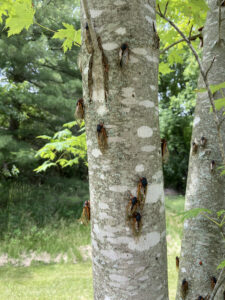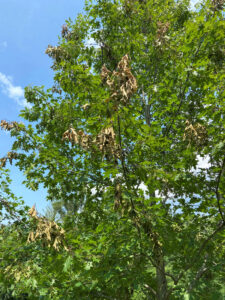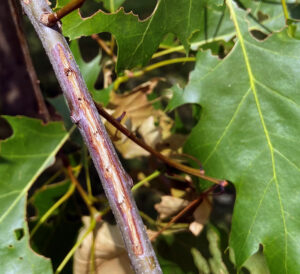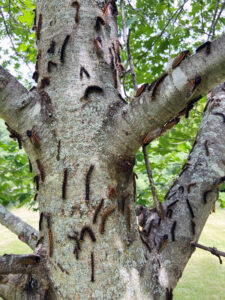By Bill McNee, DNR Forest Health Specialist, Oshkosh;
Bill.McNee@wisconsin.gov or 920-360-0942

Brood XIII periodical cicadas (Magicicada spp.) rest on a tree at Big Foot Beach State Park in Lake Geneva on June 12, 2024.
Scattered twig death, commonly known as “flagging,” was recently observed on several trees at Big Foot Beach State Park in Walworth County, where large numbers of 17-year Brood XIII periodical cicadas (Magicicada spp.) were present. This flagging is likely present in other localized sites in southern Wisconsin that experienced high numbers of cicada emergences.
The University of Wisconsin-Madison Insect Diagnostic Lab’s Periodical Cicadas in Wisconsin webpage has more information about the periodical cicada outbreak.

Oak twig death (“flagging”) due to periodical cicadas on an ornamental oak at Big Foot Beach State Park in Walworth County, June 19, 2024.
After mating, female cicadas cut slits into twigs and small branches to oviposit (lay eggs). This can kill the twig or small branch. Egg-laying may harm a small tree or shrub, but it is only a cosmetic issue on larger trees because flagging damages only a small percentage of the tree’s canopy. Placing fine netting over small trees and shrubs will prevent damage while cicadas are present.

A tree branch at Big Foot Beach State Park in Lake Geneva shows cicada oviposition slits and flagging damage on June 19, 2024. / Photo Credit: Bill McNee, Wisconsin DNR
Uncommon Co-Occurrence Of Periodical Cicadas And Spongy Moth Caterpillars
Big Foot Beach State Park has recently experienced a simultaneous outbreak of the 17-year cicadas and spongy moth caterpillars. So far, in 2024, we have only heard of two Wisconsin sites with this co-occurrence. The caterpillars experienced a heavy die-off from two diseases, creating some entomologically interesting sights before a decline in cicada numbers and wash-off of the dead caterpillars.

With a few cicadas checking out the situation, a large number of spongy moth caterpillars stand on a tree trunk at Big Foot Beach State Park in Lake Geneva in June 2024. Many of the caterpillars are hanging in the upside-down V formation that shows infection with the NPV virus; ones hanging vertically may harbor the E. maimaiga fungus. / Photo Credit: Bill McNee, Wisconsin DNR.
